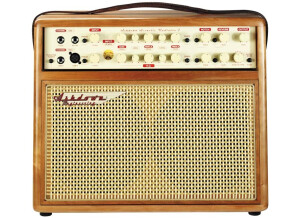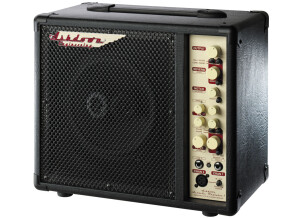Where to buy AAR1 R?
Less
There are no classified ads for this product.
Tech. sheet
- Manufacturer: Ashdown
- Model: AAR1 R
- Series: Radiator
- Category: Acoustic-Electric Guitar Amplifiers
- Other names:aar1r, aar 1 r
We have no technical specifications for this product
but your help will be much welcomed
»
User reviews
4.0/5(1 reviews)
5
4
100 %
3
2
1
Published on 10/12/14 at 02:34 (This content has been automatically translated from French)
Combo amp "transistor" type, rather an amplification of an acoustic instrument and a song vocation.
Input connectors: Jack only on channel 1, jack / XLR on channel 2
Independent settings: Active / Passive (channel 1); Shap In / Out (channel 1); Phase in / out; Eq. severe acute; input volume
Common Settings: Notch Frequency; Reverb; Master
Output: Line XLR DI Jack send / return, line
Power: 100 Watt
UTILIZATION
The configuration is simple for her, and in case of doubt, all the details pertaining to the manufacturer's manual.
We find fairly quickly a suitable setting that matches its desire for a very good sound result.
SOUNDS
For acoustic instruments, we look rather...…
Input connectors: Jack only on channel 1, jack / XLR on channel 2
Independent settings: Active / Passive (channel 1); Shap In / Out (channel 1); Phase in / out; Eq. severe acute; input volume
Common Settings: Notch Frequency; Reverb; Master
Output: Line XLR DI Jack send / return, line
Power: 100 Watt
UTILIZATION
The configuration is simple for her, and in case of doubt, all the details pertaining to the manufacturer's manual.
We find fairly quickly a suitable setting that matches its desire for a very good sound result.
SOUNDS
For acoustic instruments, we look rather...…
Read more
Combo amp "transistor" type, rather an amplification of an acoustic instrument and a song vocation.
Input connectors: Jack only on channel 1, jack / XLR on channel 2
Independent settings: Active / Passive (channel 1); Shap In / Out (channel 1); Phase in / out; Eq. severe acute; input volume
Common Settings: Notch Frequency; Reverb; Master
Output: Line XLR DI Jack send / return, line
Power: 100 Watt
UTILIZATION
The configuration is simple for her, and in case of doubt, all the details pertaining to the manufacturer's manual.
We find fairly quickly a suitable setting that matches its desire for a very good sound result.
SOUNDS
For acoustic instruments, we look rather traditional for them a clean and clear: it is obtained for a great result.
Connected with an acoustic guitar, it works great with a full sound, restoring the proper characteristics of the instrument accurately. Good presence in all the registers: low, mid, treble.
I try archtop jazz guitar with very good (see my gear) and the sound quality really like me! ...
With a trendy micro channel 2, the set still works fine. There should always be a balance input only because the master volume it is common for the use and engagement of the reverb too ...
Personally, I prefer the sound "shape" engaged that I find most rewarding musically.
OVERALL OPINION
After selling my AER Compact 60 (for financial reasons), I ventured to the purchase of used it as a replacement of emergency: I am so pleasantly surprised and overall rather positive:
The EAR (even 60 Watt) has more power, it's clear. On the other hand it is right, transparent, makes no sound color, just restoring what branch above a pro but also a little tight as it can be perceived as such as "cold" seeing "impersonal" .
This is where the Ashdown surprised me: it restores itself but the sound of instruments (especially shape on) he adds nothing of heat, little compression that enhances the instrument and enhances the color just what it takes for me.
Ashdown with this, I find myself a little less on the razor's edge, a bit more "reassured" by a sound and I find it more musically carrier ...
100 watts is enough, he should not less! ... I feel such less comfortable trying "outdoor" ...
I have tried other brands: Acus, Schertler, Roland and also Carlsbro, Peavey.
With AER, the first three of these have good acoustic amp models, I especially like Roland to render the AC with nylon string guitars.
This model Ashdown "Radiator" remains a good opportunity challenger because it does its job: it appears to me as reliable, offers good sound quality!
Input connectors: Jack only on channel 1, jack / XLR on channel 2
Independent settings: Active / Passive (channel 1); Shap In / Out (channel 1); Phase in / out; Eq. severe acute; input volume
Common Settings: Notch Frequency; Reverb; Master
Output: Line XLR DI Jack send / return, line
Power: 100 Watt
UTILIZATION
The configuration is simple for her, and in case of doubt, all the details pertaining to the manufacturer's manual.
We find fairly quickly a suitable setting that matches its desire for a very good sound result.
SOUNDS
For acoustic instruments, we look rather traditional for them a clean and clear: it is obtained for a great result.
Connected with an acoustic guitar, it works great with a full sound, restoring the proper characteristics of the instrument accurately. Good presence in all the registers: low, mid, treble.
I try archtop jazz guitar with very good (see my gear) and the sound quality really like me! ...
With a trendy micro channel 2, the set still works fine. There should always be a balance input only because the master volume it is common for the use and engagement of the reverb too ...
Personally, I prefer the sound "shape" engaged that I find most rewarding musically.
OVERALL OPINION
After selling my AER Compact 60 (for financial reasons), I ventured to the purchase of used it as a replacement of emergency: I am so pleasantly surprised and overall rather positive:
The EAR (even 60 Watt) has more power, it's clear. On the other hand it is right, transparent, makes no sound color, just restoring what branch above a pro but also a little tight as it can be perceived as such as "cold" seeing "impersonal" .
This is where the Ashdown surprised me: it restores itself but the sound of instruments (especially shape on) he adds nothing of heat, little compression that enhances the instrument and enhances the color just what it takes for me.
Ashdown with this, I find myself a little less on the razor's edge, a bit more "reassured" by a sound and I find it more musically carrier ...
100 watts is enough, he should not less! ... I feel such less comfortable trying "outdoor" ...
I have tried other brands: Acus, Schertler, Roland and also Carlsbro, Peavey.
With AER, the first three of these have good acoustic amp models, I especially like Roland to render the AC with nylon string guitars.
This model Ashdown "Radiator" remains a good opportunity challenger because it does its job: it appears to me as reliable, offers good sound quality!
See less
20
»
Other Ashdown acoustic-Electric Guitar Amplifiers
Other categories in Guitar amplification
Where to buy AAR1 R?
Less
There are no classified ads for this product.







